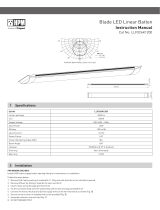
1. Prepare the switch box.
After the power is turned OFF at the circuit
breaker box, remove the existing wall plate and
mounting screws. Pull the old switch out from
the wall box.
2. Identify the type of circuit.
In a Single Pole Circuit (see Fig. 2), two single
wires connect to two screws on the existing
switch. A ground wire may also be present
and connected to a ground terminal on the
old switch.
CAUTION – FOR YOUR SAFETY: Connecting a proper ground to the
sensor provides protection against electrical shock in the event of
certain fault conditions. If a proper ground is not available, consult
with a qualified electrician before continuing installation.
Only connect the RW500U to a Single Pole Circuit. The RW500U is not
suitable for 3-way switching. If the existing wiring does not match the
description for a Single Pole Circuit, you should consult with a qualified
electrician. If 3-way switching is required, use P&S 3-way occupancy
sensor, RW3U600.
3. Prepare the wires.
Tag the wires connected to the existing switch, so that
they can be identified later. Disconnect the wires. Make
sure the insulation is stripped off the wires to expose
their copper cores to the length indicated by the “Strip
Gage” (in Fig. 3) (approx. 1/2 inch).
DESCRIPTION AND OPERATION
The RW500U Occupancy Sensor Switch is designed to replace a residential light
switch. It is ideal for laundry rooms, utility rooms, storage areas, closets and any
other indoor area in a residential building where occupancy sensor-based
automatic ON/OFF controls are desirable. The sensor requires no adjustments to
operate successfully in those particular applications for which it was designed.
Lighted Switch
To help you locate the RW500U in a dark room, a green LED illuminates the
ON/OFF button while the controlled light (load) is OFF. When the load is ON,
the LED is OFF.
Push Button
The push button can be used to manually turn ON and OFF the load. To turn
the load OFF, tap firmly on the push button once. The lighted switch will turn ON
and the load will turn OFF. If the load is turned OFF manually, Automatic-ON is
reenabled when no motion is detected for 5 minutes.
Time Delay
The RW500U has a fixed time delay of 5 minutes. Lights will remain ON for
5 minutes after the last motion detection.
Coverage Area
The RW500U has a maximum range of
180 degrees and a coverage area of
600 sq. feet (56 sq, meters). The sensor must
have a clear and unobstructed view of the
coverage area. Objects blocking the sensor’s
lens may prevent detection thereby causing
the light to turn OFF even though someone
is in the area.
Windows, glass doors, and other transparent barriers will obstruct the
sensor’s view and prevent detection.
WARNING
Disconnect power to the wall switch box by turning OFF the circuit
breaker or removing the fuse for the circuit before installing the
RW500U, replacing lamps, or doing any electrical work.
INSTALLATION & WIRING
Fig 2: Typical Single Pole
Switch Wiring
Fig 3: Wire Stripping
Visit our website at: www.passandseymour.com
Call 800.223.4185 for Technical Support
Fig. 1: Sensor Coverage Area
4. Wire the sensor.
Twist the existing wires
together with the wire leads on
the RW500U sensor as
indicated below. Cap them
securely using the wire nuts
provided (see Fig 4).
• Connect the green or non-
insulated (copper) GROUND
wire from the circuit to the
green wire on the RW500U.
• Connect the power wire from
the circuit box (HOT) to the
black wire on the RW500U.
• Connect the wire to the lamp
(LOAD) to the red wire on the
RW500U.
5. Put the RW500U in the
wall box.
Position the lens above the
ON/OFF button (lens at top,
button at bottom) and secure it to
the wall box with the screws provided.
6. Attach the new cover plate.
Secure it to the wall box with the
screws provided.
7. Restore power to the circuit.
Turn ON the breaker or replace the fuse.
8. Test the sensor’s operation.
See TEST MODE.
Initial Power-up Delay
There is an initial warm-up
period the first time power is
applied to the unit and after
a power failure lasting more
than 5 minutes. It may take
up to 1 minute before the
lights turn ON. However, the
lights can be turned ON/OFF
manually by pressing the
ON/OFF button at any time
when power is supplied to
the unit.
Fig. 4: Sensor orientation, wire connections
and wall box assembly
340800_RevB_IS_12266 4/23/07 9:55 AM Page 4



